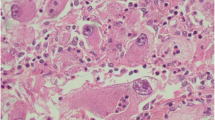Abstract
Choroid melanoma is a rare but primary ocular malignancy in adults, with an annual incidence of 6–7 cases per million people. Treatment options include radiotherapy (plaque brachytherapy, proton beam or stereotactic radiotherapy) and laser therapy. Transretinal endoresection using vitrectomy of choroidal tumors is performed only in a few centers because it requires special skills and hypotensive anesthesia, and also because of the concern of tumor seeding.
You have full access to this open access chapter, Download chapter PDF
Similar content being viewed by others
Choroid melanoma is a rare but primary ocular malignancy in adults, with an annual incidence of 6–7 cases per million people. Treatment options include radiotherapy (plaque brachytherapy, proton beam or stereotactic radiotherapy) and laser therapy. Transretinal endoresection using vitrectomy of choroidal tumors is performed only in a few centers because it requires special skills and hypotensive anesthesia, and also because of the concern of tumor seeding.
Beijing Tongren Eye Center reported three cases of life-threatening complication of acute pulmonary embolism (APE) out of 682 cases of uveal melanoma local resection surgery during 1997–2011. All these three APE occurred within hours after surgery. The patients complained of discomfort, chest tightness, chest pain, and gasp with cyanosis. The BP dropped below 90/60 mmHg, and ECG showed sinus tachycardia, lung-shaped P wave, and change in ST-T and SITIII. The blood gas analysis showed lowered PaO2, elevated PaCO2, and lowered SaO2. Ultrasonic cardiogram detected right ventricular enlargement. Chest X-ray showed pleural effusion. Two patients died and one patient received thoracentesis, low-molecular-weight heparin, and warfarin for anticoagulant therapy and eventually recovered.
The mechanism of emboli remains unknown. It is speculated that the emboli in these three cases may be derived from lower extremity venous thrombus. The first two patients, who died, received general anesthesia with controlled hypotension. The intraoperative BP was lowered to 75/40 mmHg or 90/50 mmHg. The third patient received local anesthesia, and the BP was maintained normal during surgery. Since none of these two death cases underwent biopsy examination, other embolism sources including tumor tissue and silicone oil droplets could not be ruled out. Hypotensive general anesthesia reduced surgical bleeding, but it could also be a predisposing factor of thrombosis. The third patient received local anesthesia instead of general anesthesia; therefore it is also speculated that local resection surgery could possibly trigger the stress response and lead to embolism.
Author information
Authors and Affiliations
Editor information
Editors and Affiliations
Rights and permissions
Copyright information
© 2020 Springer Nature Singapore Pte Ltd. and People's Medical Publishing House, PR of China
About this chapter
Cite this chapter
Yu, W. (2020). Acute Pulmonary Embolism After Local Resection of Choroidal Melanoma. In: Wang, N. (eds) Integrative Ophthalmology. Advances in Visual Science and Eye Diseases, vol 3. Springer, Singapore. https://doi.org/10.1007/978-981-13-7896-6_37
Download citation
DOI: https://doi.org/10.1007/978-981-13-7896-6_37
Published:
Publisher Name: Springer, Singapore
Print ISBN: 978-981-13-7895-9
Online ISBN: 978-981-13-7896-6
eBook Packages: MedicineMedicine (R0)




